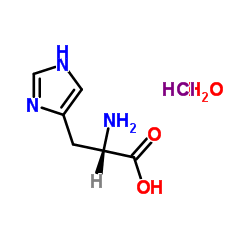L-Histidine hydrochloride monohydrate

L-Histidine hydrochloride monohydrate structure
|
Common Name | L-Histidine hydrochloride monohydrate | ||
|---|---|---|---|---|
| CAS Number | 5934-29-2 | Molecular Weight | 209.631 | |
| Density | 1.485 g/cm3 | Boiling Point | 458.9ºC at 760 mmHg | |
| Molecular Formula | C6H12ClN3O3 | Melting Point | 254 °C (dec.)(lit.) | |
| MSDS | USA | Flash Point | 231.3ºC | |
|
Prevalence and Characterization of High Histamine-Producing Bacteria in Gulf of Mexico Fish Species.
J. Food Prot. 78 , 1335-42, (2015) Recent developments in detection and enumeration of histamine-producing bacteria (HPB) have created powerful molecular-based tools to better understand the presence of spoilage bacteria and conditions, resulting in increased risk of scombrotoxin fish poisonin... |
|
|
Enhanced signal intensity in matrix-free laser desorption ionization mass spectrometry by chemical modification of bionanostructures from diatom cell walls.
Rapid Commun. Mass Spectrom. 28(13) , 1521-9, (2014) Laser desorption ionization for mass spectrometric measurements (LDI MS) is supported by nanostructured materials. This technique helps to overcome known limitations of matrix-assisted laser desorption/ionization (MALDI) and especially avoids interfering sign... |
|
|
A 3D-printed device for a smartphone-based chemiluminescence biosensor for lactate in oral fluid and sweat.
Analyst 139(24) , 6494-501, (2014) Increasingly, smartphones are used as portable personal computers, revolutionizing communication styles and entire lifestyles. Using 3D-printing technology we have made a disposable minicartridge that can be easily prototyped to turn any kind of smartphone or... |
|
|
Fundamental analysis of recombinant human epidermal growth factor in solution with biophysical methods.
Drug Dev. Ind. Pharm. 41(2) , 300-6, (2015) Correlation of thermodynamic and secondary structural stability of proteins at various buffer pHs was investigated using differential scanning calorimetry (DSC), dynamic light scattering (DLS) and attenuated total reflection Fourier-transform infrared spectro... |
|
|
Particle shedding from peristaltic pump tubing in biopharmaceutical drug product manufacturing.
J. Pharm. Sci. 104(4) , 1440-50, (2015) In a typical manufacturing setup for biopharmaceutical drug products, the fill and dosing pump is placed after the final sterile filtration unit in order to ensure adequate dispensing accuracy and avoid backpressure peaks. Given the sensitivity of protein mol... |
|
|
The metabolism of histamine in rat hypothalamus and cortex after reserpine treatment.
Neurochem. Int. 85-86 , 31-9, (2015) The effect of reserpine on histamine (HA) and tele-methylhistamine (N(τ)-MHA) in hypothalamus and cortex of rats was analyzed and compared to catecholamines. IP injection of reserpine (5 mg/kg) confirmed the effectiveness of reserpine treatment on noradrenali... |
|
|
Boron stimulates yeast (Saccharomyces cerevisiae) growth.
J. Nutr. 129(12) , 2236-8, (1999) Boron is required for the growth of vascular plants and embryonic development in fish. The molecular basis of boron's essentiality, however, remains unknown for both. The objective of this study was to determine whether yeast (Saccharomyces cerevisiae) could ... |
|
|
Insect cells as factories for biomanufacturing.
Biotechnol. Adv. 30(5) , 1140-57, (2011) Insect cells (IC) and particularly lepidopteran cells are an attractive alternative to mammalian cells for biomanufacturing. Insect cell culture, coupled with the lytic expression capacity of baculovirus expression vector systems (BEVS), constitutes a powerfu... |
|
|
Heterologous protein production capacity of mammalian cells cultivated as monolayers and microtissues.
Biotechnol. Bioeng. 93 , 169-180, (2006) A precise understanding of processes managing heterologous protein production in vitro and in vivo is essential for the manufacture of sophisticated biopharmaceuticals as well as for future gene therapy and tissue engineering initiatives. Capitalizing on the ... |
|
|
Tissue engineering and regenerative medicine: manufacturing challenges.
IEE Proc. Nanobiotechnol. 152 , 207-210, (2005) Tissue engineering and regenerative medicine are interdisciplinary fields that apply principles of engineering and life sciences to develop biological substitutes, typically composed of biological and synthetic components, that restore, maintain or improve ti... |